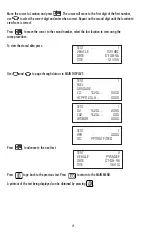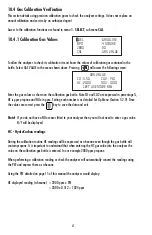
28
10.4.2 Calibration Check
You should perform a calibration check when ever you suspect an error or at a minimum of 450 hours. Select
CHECK from the screen above and press
The instrument will request a ZERO CHECK, see Section 10.1, once complete, proceed as follows:
WARNING!
Use calibration gas in well ventilated areas. Fumes may cause nausea and headaches.
Connect the calibration gas to the water trap connection on the analyzer using the hose provided.
Important: To prevent damage to the analyzer, be sure to use the pressure regulator
between the analyzer and the gas bottle. Read the instructions supplied with the calibration
gas carefully.
Open the gas valve on the calibration bottle. The following screen will display the change in gas values as the
analyzer detects the calibration gas.
The instrument will automatically perform a gas check within 60 seconds. The number 30 will countdown to
give an indication of calibration status. Messages on the screen as follows:
•
CONNECT GAS
when the analyzer is waiting for calibration gas to be applied.
•
NO GAS DETECTED
will be displayed after 30 seconds if the instrument does not see changes
in the gas values. Check the gas valve has been opened, the fittings are secure and that there is
sufficient pressure in the bottle. Fails test and returns to main screen.
•
DETECTING GAS
when the analyzer has started to read calibration gas and is stabilizing –
normally within about 5-10 seconds.
•
GAS UNSTABLE
message is displayed after the instrument has detected gas for 30 seconds
but readings fluctuate. Fails test and returns to main screen.
F
UEL
: GASOLINE
RPM
: 4 STROKE
ZERO
: NO
CAL
: GAS VALUE
CALIBRATION CHECK
CONNECT CAL GAS
THEN PRESS ENTER
CALIBRATION CHECK
CO : 3.50
CO2 : 14.0
HC : 2000
NOX : 1000
CONNECT GAS 30









































